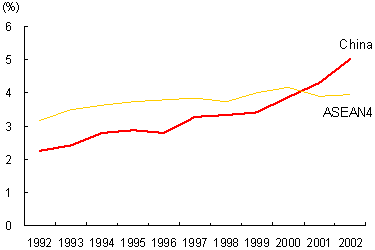The effects of China's rise on other Asian economies depend heavily on whether a country is in a complementary or competitive relationship with China. In the case of the members of the Association of Southeast Asian Nations (ASEAN), the composition of their export and import items is similar to that of China, and the relationship is competitive. In contrast, Japan's export and import structures are similar to China's import and export structures, and the two are in a complementary relationship. If a complementary relationship were to be described as a win-win game, a competitive relationship, unfortunately, threatens to become a zero-sum game. If ASEAN countries are to sustain their economic development, they must make adjustments to their industrial structure while establishing a division of labor with China.
For ASEAN members, a continued fall in the prices of Chinese products could lead to a decline in export prices and a deterioration of their terms of trade. This is because they are in fierce competition with China, not only in their own country and China, but also in third country markets. As a result, they must lower the prices of their goods to match the reduction in the prices of Chinese products. From the standpoint of individual companies, if earnings drop by that amount then firms that cannot withstand this have no choice but to go bankrupt. This contrasts with the position of most Japanese firms, which benefit through a reduction in production costs with lower import prices from China and a rise in profits.
The negative effects do not end at prices. While the volume of both trade and direct investment in China is rising sharply, ASEAN has lagged behind in both areas. In recent years, growth in China's exports has been outpacing that of ASEAN's and since 2001, the value (and thus global share) of China's exports has surpassed that of ASEAN4 (Indonesia, Malaysia, the Philippines and Thailand) ( diagram ). We have also seen a shift in direct investment from ASEAN to China. For example, Japan's direct investment in China during the first half of fiscal 2003 surged 35.5% on a year-on-year basis, but investment in ASEAN fell 14.6% during the same period (in yen terms, according to Ministry of Finance statistics).
Nevertheless, for the time being we do not see any indication of "China Syndrome," or feeling that China is a threat, among ASEAN members. This is because their exports to China are continuing to increase. However, a major reason why their exports to other countries are slowing down also lies in China. In the end, it is questionable whether such "China factors" together will serve to benefit the ASEAN economies. In addition, it is highly probable that the surge in exports to China may be a phenomenon seen in a transitional phase. Foreign-affiliated firms (especially parts and machinery manufacturers) are the main entities exporting from ASEAN to China, and if they decide to shift their production facilities to China, exports to China will no longer experience the rapid pace of growth of recent years.
In the end, when it comes to considering a division of labor with China, the issue for ASEAN countries is where to seek their comparative advantage. Two scenarios are possible. First, they can try to provide products and manufacturing processes with higher value added than those in China. But, because the realization of this "industrial upgrading" scenario is largely dependent on the trends of foreign direct investment it may not be easy given recent developments. The other scenario is deindustrialization. The ASEAN nations are blessed with mineral resources such as oil and natural gas, and also are very competitive internationally in foodstuffs (Thai rice and fruit from the Philippines) and agricultural products for industrial use (Malaysia's rubber). As China's industrialization progresses, demand for primary products is likely to grow steadily. This signifies not only an increase in China-bound exports from ASEAN, but also a rise in export prices and, as a result, an improvement in its terms of trade. While relapsing to the status of primary product exporters may sound pessimistic, there are countries such as Australia whose people enjoy a high standard of living even if they are exporters of primary products, so long as the terms of trade are in their favor.
As this shows, there is no doubt that China's rise will trigger adjustments in the industrial structures of ASEAN nations. Furthermore, progress in the signing of free trade agreements between ASEAN and China is also likely to encourage the formation of a division of labor that is in line with their respective comparative advantages. No matter which scenario is realized - industrial upgrading or deindustrialization - the relationship between the industrial structures of ASEAN and China is likely to become more complementary in the end.
Diagram: China's share of world exports surpassing ASEAN4

(Note) ASEAN4 are Indonesia, Malaysia, the Philippines and Thailand
(Source) World Trade Organization


